
|
Human depictions on ancient Indian coins are of special interest, as
they are among India's earliest
representations of deities in anthropomorphic form and thus most
important for the study of their iconographic development. The earliest such
depictions on coins appear on some of the punchmarked silver
karshapanas of the Mauryan kings during the 4th/3rd century BCE. The
deities on these early silver coins have been identified as crested
Shiva holding danda (stick) and kamandalu (water-pot), as ithyphallic
Shiva on one rare type from the Jan Lingen collection, as chakra
(discus-weapon) holding Vaishnavite deity Vasudeva-Krishna or as plough
holding Balarama. A number of female figures on some of these silver
karshapana types have been regarded as Matrikas. And a unique silver
karshapana from the Pieper collection depicts a chakra holding Vaishnavite
deity / Vishnu together with what appears to be the earliest depiction of a
Garuda.
On
the local Ujjain coins with human depictions on them, these are in most
cases single human figures, standing, squatting, dancing
or sitting, representing various Hindu gods and goddesses. Different
researchers have tried to identify them and have frequently come to
divergent conclusions. The matter is not simple as in this early stage
of iconography the depiction of many deities together with their
characteristic symbols and attributes was not yet fully developed and
sometimes different deities were even associated with the same symbols.
The latest approach to the subject is Devendra Handa's brilliant paper
on 'Divinities on Ujjain Coins', ICS-NL 51, 2013' who clarified
controversies on some deities and originally proposed the
identification of others. The most prominent figure on
these coins is ceratainly Shiva Mahakala whose cult was very important at Ujjain, and Lakshmi who experienced a
general adoration by believers of different cults who wouldn't have
hesitated to beg assistance from the goddess of wealth, prosperity and
fortune.
But
apart from Shiva and Lakshmi there are several other deities who are
depicted on the coins of ancient Ujjain, such as Karttikeya, Shashthi,
Vasudhara, Krishna, Brahma and others, according to the well-founded
identifications of Devendra Handa. Further details will be given with
the respective coin descriptions below. Handa refers to some coins
published by Sethi depicting a male human figure which either holds a
bull or cow by its horn, or which drives a bull/ cow holding a stick in
his hand, and proposes to identify this figure as Gopala Krishna
(ICS-NL, no.51, pp.25-26). In the same context he proposes to regard
another figure as a Krishna depiction as well: this figure appears on a
coin published by Kothari which shows a dancing male figure with
fan-shaped hairdress holding a flute-like object. Kothari's coin
type 252 is seen by Handa as a depiction of Karttikeya (ICS-NL, 51,
p.31); the deity is holding shakti (lance) and kamandalu (water-pot)
and shows five protrusions of the head-gear as a "representation of
six-headed Karttikeya." In a similar way goddess Shashthi is identified
by Handa on another Ujjain coin type depicted as a multi-headed
female figure as indicated by the
dotted marks around her head. The 'fish-holding deity' was already
described by V.S. Agrawala as a representation of Vasudhara who is the
consort of Jambhala- the Buddhist god of wealth.
A
few early copper coins of the Ujjain region with three standing/
walking human figures on them are of special interest. Combining the
evidence of the specimens at his disposal Devendra Handa identified
this group of three figures, a female figure in the center with a
bow-holding male figure on each side, as the earliest numismatic
depictions of Rama, Sita and Lakshmana datable to the 2nd/ 1st century
BC (ICS-NL, no.51, pp.29-30). "The dress of the female figure
compares very well with the dress of numerous human figures which
figure on Ujjain coins and leaves little doubt to its being an
indigenous piece of the area. The three figures with two males holding
the bows seem to represent Rama, Sita and Lakshmana going in the forest
and recall to our mind the description given in the Valmiki Ramayana".
|
|
 |
UJJAIN diverse deities
|

|
Ujjain, anonymous AE 3/8 karshapana, 'seated Lakshmi type'
Weight: 3.18 gm., Diameter: 16 mm.
Seated Lakshmi with feet parallel to each other, right hand on leg and
left hand raised holding lotus flower.
Ujjain symbol.
Reference: Pieper 304 (plate coin) / BMC pl.XXXVIII, no.25
|
 |
Lakshmi, the wife of
Vishnu, is the goddess of fortune, wealth and prosperity and one of the
most popular divinities from the Hindu pantheon. Incarnations of Vishnu
are Rama and Krishna, as incarnations of Lakshmi are Sita (Rama's wife)
and Radha (Krishna's lover). Lakshmi has a special association to the
lotus flower which stands for growth and fertility- so much that even the world
is said to be continually reborn from a lotus which comes out of the
navel of Vishnu.
|
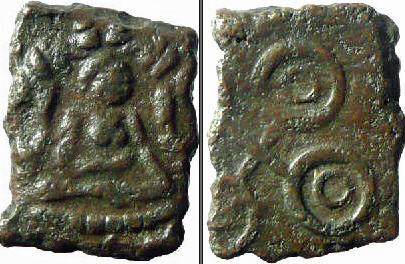
|
Ujjain, anonymous AE 3/8 karshapana, 'abisheka-Lakshmi txpe'
Weight: 3.10 gm., Diameter: 15x11 mm.
Lakshmi seated with feet parallel to each other, her right rests on her
belly and her left on her leg; Lakshmi is flanked by two elephants
which are sprinkling water on her head (abisheka Lakshmi).
Reference: Pieper 305 (plate coin) / BMC pl.XXXVI, nos.4-5
|
 |
Abisheka is a late
Vedic rite originally performed by anointing government officials at
special occasions. In Hindu worship the abisheka ritual is particularly
connected with Lakshmi, though it is also performed by other believers.
'Rudraabisheka' for example is peformed on Shiva lingams. As can be seen on this
coin Lakshmi is frequently depicted with two elephants adoring her by pouring water over her head.
|
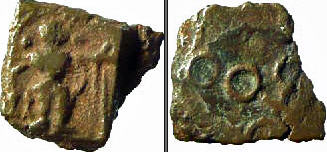
|
Ujjain, anonymous AE 1/8 karshapana, 'fish-holding Vasudhara'
Weight: 1.00 gm., Diameter: 8x8 mm.
Standing goddess Vasudhara holding a pair of fish with her outstretched
right, left hand akimbo.; standard on right.
Ujjain symbol with extra circle in field.
Reference: Pieper 295 (plate coin)
|
 |
The fish-holding
goddess is known on coins and sculptural objects from Malwa, Vidarbha,
Mathura, Kausambi and elsewhere and has been identified as Vasudhara, a
goddess of wealth and auspiciousness. Like Lakshmi she was
popular among traders and others who searched protection and promotion
for their diverse activities. Handa emphasizes the symbolic importance
of the pair of fish "as one of the eight mangalika-chihnas 'auspicious
signs' in literature".
|

|
Central India, AE 1/8 karshapana,'fish-holding Vasudhara'
Weight: 1.01 gm., Diameter: 8x8 mm.
Standing goddess Vasudhara holding a pair of fish with her outstretched
right, left hand akimbo; she wears large earrings and pinned up hair (as
if wearing a vessel on her head); svastika on the top left.
Lion standing to right
Reference: Pieper 452 (plate coin)
|
 |
The provenance of
this and the next coin is uncertain but may be assumed to be in western Malwa or
closely linked regions south of the Narmada.
|
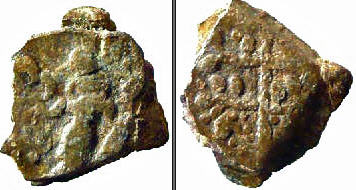
|
Central India, AE 1/8 karshapana, 'fish-holding Vasudhara'
Weight: 1.17 gm., Diameter: 11x8 mm.
Standing goddess Vasudhara holding a pair of fish with her outstretched
right, left hand akimbo; her hair is pinned up (as if wearing a vessel on
her head; two crescent-like devices on the left.
Tree
Reference: Pieper 453 (plate coin)
|
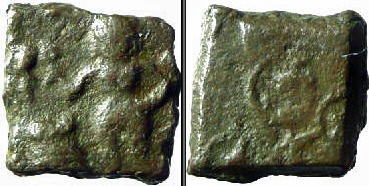
|
Ujjain, AE 1/4 karshapanaa, 'snake holding deity'
Weight: 2.83 gm., Diameter: 11x11 mm.
Frontally facing female figure, her left arm akimbo, her right raised hand holding
an uncertain object; on the left is a curved object like a snake
coming from a large basket that is standing at the bottom.
Ujjain symbol.
Reference: Pieper 296 (plate coin)
|
 |
It is possible that
this is also a depiction of 'fish-holding' Vasudhara but there are some
differences. The uplifted right is unusual and the fact that the deity
would be holding one of the two fish directly in her hand seems to be
unusual as well. Usually Vasudhara is holding the pair of fish with a
string so that they are hanging below her outstretched hand. To me it
looks more as if she was holding a snake in her hand and the curved
object on left as well bears more resemblance to a snake. And the
basket which is standing at the bottom reminds one of the baskets in
which snake charmers keep their snakes. If this interpretation was true,
the depicted figure might be a serpent goddess such as Manasa who is
particularly worshipped in Bengal but also in other parts of northern
and north-eastern India.
|
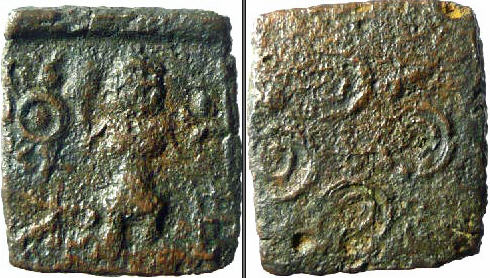
|
Ujjain, anonymous AE 3/8 karshapana, 'Annapurna type'
Weight: 3.17 gm., Diameter: 17x15 mm.
Frontally standing female figure holding a vase or pot in her upraised right
hand, left akimbo; 6-armed symbol on top left; horizontally placed
Indradhvaja and taurine on bottom left; railed tree on right.
Double-orbed Ujjain symbol.
Reference: Pieper 294 (plate coin) /BMC pl.XXXVII, no.21
|
 |
Handa suggested that
the female on this coin may represent Annapurna (ICS-NL, 51, p.35).
Annapurna is the Hindu goddess of nourishment, food, harvest and
agriculture and hence very popular in the villages and rural regions of
India. She is regarded as another form of Parvati, the consort of
Shiva. Annapurna is depicted holding a bowl or pot filled with grain or
other food. Her main temple stands in Varanasi but others are known
at many other places among them a very famous one at Indore in Madhya
Pradesh.
|

|
Ujjain, anonymous AE 3/4 karshapana, 'taurine-holding deity'
Weight: 3.00gm., Diameter: 15x14 mm.
Frontally standing female figure holding taurine in raised left, right akimbo;
chakra above Ujjain symbol on left; svastika above railed tree on right.
Ujjain symbol with a svastika in each orb.
Reference: Pieper 298 (plate coin)/ BMC pl.XXXVII, no.8
|
 |
The identity of this taurine holding female remains uncertain at the moment.
|

|
Ujjain, anonymous AE 1/4 karshapana, 'six-headed Shashthi type'
Weight: 1.95 gm., Diameter: 14x12 mm.
Simplified female figure frontally standing, both arms hanging down; railed
tree on right; river line at the bottom.
Ujjain symbol with svastika in each angle.
Reference: Pieper 300 (plate coin)
|
 |
Referring to
depictions of six-headed Shashthi on some Yaudheya coins Devendra Handa
takes the five dots around the main head of the female on this coin
type as additional heads and identifies her as Shashthi on this Ujjain type as well
(ICS-NL, 51, p.34).
|

|
Ujjain, anonymous AE 3/8 karshapana, 'shoulder decorated deity'
Weight: 3.30 gm., Diameter: 15x15 mm.
In square incuse standing human on left with rings (bracelets) around the
shoulders; Ujjain symbol in center; hand or footprint symbol on right;
horizontally placed railed tree at top; river at the bottom.
Reference: Pieper 297 (plate coin)
|
 |
The identity of this peculiar human figure with the circles / rings/ ornaments at the shoulders is still open.
|

|
Ujjain, anonymous AE 3/8 karshapana,'Balarama & ass-demon'
Weight: 3.86 gm., Diameter: 15x14 mm.
Human figure on left holding stick and kamandalu standing towards a
horse-like animal which faces him from right; palm tree on right; Ujjain
symbol on top; a taurine above the animal and taurine and svastika at
the bottom.
Ujjain symbol with a svastika in each orb and taurines in the angles.
Reference: Pieper 346
|
 |
In a note to the
SACG website Shailendra Bhandare suggested the scene on this coin
representing the mythical story of 'Balarama killing the ass demon' and
the depiction seems to reflect that story indeed quite well- even if
the deity on this coin has no specific Vaishnavite attributes. We are
told that there had been a large grove where there were palmyras
bearing delicious fruits. But nobody dared to go there because the site
was guarded by Dhenuka, a demon in the form of an ass. Finally Balarama, inseparable companion of Krishna, killed
the demon by crashing him against one of the palm trees. In his contribution to 'Between the Empires' Bhandare discusses the story of
'Balarama killing the ass-demon' in the context of the coinage of Erikachha where the palm-tree and ass had been characteristic coin
devices. Typologically this coin type may thus rather belong to Erikachha than to Ujjain.
|
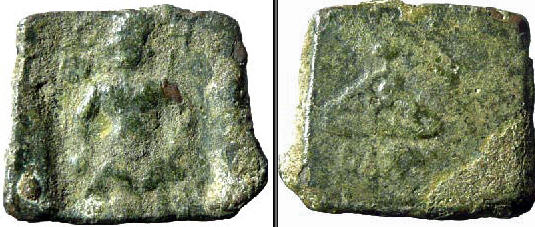
|
Ujjain, anonymous AE, 'Brahma type'
Weight: 2.84 gm., Diameter: 14x14 mm.
Standing male figure holding long curved staff and kamandalu (water-pot)
Ujjain symbol on top left and Brahmi legend 'bramha' on top right.
Six-arched chaitya (hill/ multiarched structure) with indistict object on top;
indistinct Brahmi legend below the chaitya .
Reference: Pieper 410 (plate coin)
|
 |
In ICS-NL, no.50,
p.31-32, Devendra Handa identified the deity on this coin type as
Brahma as it is clearly indicated by the Brahmi legend on the right top
corner of the obverse. Handa discusses the possibility that the object
on top of the chaitya on reverse might be a swan (vahana or vehicle of
Brahma) on post. Taking the chaitya symbol representing a temple in
this case, it thus might be a temple dedicated to god Brahma. Brahma,
creator of the universe, is part of the Hindu trinity together with
Vishnu and Shiva. Although usually Brahma is represented as a
four-armed deity with certain specific attributes, one cannot expect
these features here, as the iconography was not yet developed that far
and nowhere on these early coins do we see multi-armed deities. Staff
and kamandalu (water-pot) are unspecific attributes which Brahma shares
with other deities.
|
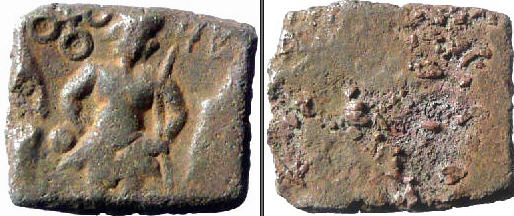
|
Ujjain, anonymous AE 3/8 karshapana, 'Brahma type'
Weight: 3.28 gm., Diameter: 15x13 mm.
Like the previous specimen but reverse design blank or corroded.
Reference: Pieper 411 (plate coin)
|
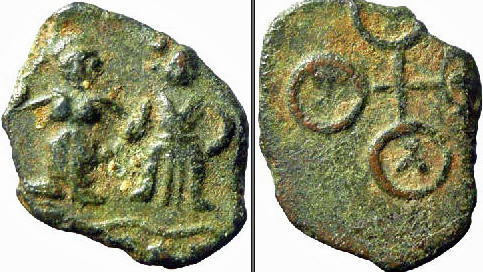
|
Ujjain, anonymous AE 1/4 karshapana, 'standing couple type'
Weight: 2.81 gm., Diameter: 17x15 mm.
Standing male and female human figure side by side holding hands, female's
right hand raised to her head, male's left akimbo, hair decorations
on both sides of the male's head; river at the bottom.
Ujjain symbol with a taurine in each orb.
Reference: Pieper 302 (plate coin)/ BMC pl.XXXVI, nos.1-3
|
 |
Several attempts
have been made in the past to identify the two figures on this coin
type. Amongst other explanations some researchers have tried to
interpret the scene as representing the marriage of Shiva and Parvati
but there is no clear evidence for any such definite attribution. In
the abscence of any specific attributes one can only describe the scene
as a depiction of a closely attached human couple.
|
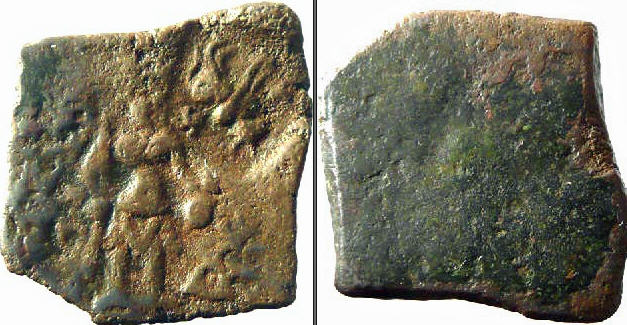
|
Ujjain region, c/m anonymous AE 1/2 karshapana
Weight: 3.96 gm., Diameter: 17x17 mm.
Standing male figure holding kamandalu (water-pot) and danda (stick);
wheel above six-armed symbol on left; three-arched hill with crescent
on top right; countermark on top right depicting a bull with svastika and
taurine.
Blank reverse.
Reference: Pieper 417 (plate coin) / see Kothari 267 for undertype
|

|
Ujjain region, c/m anonymous AE karshapana
Weight: 7.64 gm., Diameter: 21x21 mm.
Countermark (=standing human figure holding stick and kamandalu) on the
blank reverse of an Ujjain region coin.
Worn traces of undertype: three-arched hill, Ujjain symbol, six-armed-
symbol and river.
Reference: Pieper 418 (plate coin) / compare Kothari 325
|
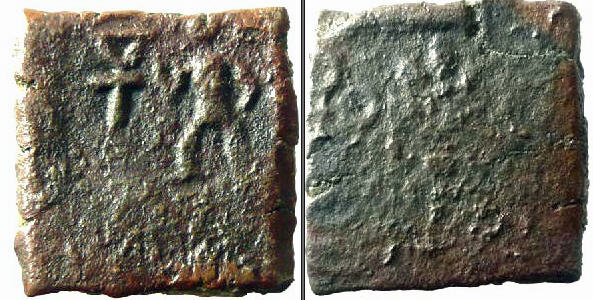
|
Ujjain region, c/m anonymous AE 1/2 karshapana
Weight: 5.13 gm., Diameter: 16x15 mm.
Countermark (=standing human figure, his left akimbo, his right raised;
Indradhvaja on left).
Faint traces of worn undertype of which Ujjain symbol and parts of a tree
are visible.
Reference: Pieper 421 (plate coin) / see Kothari 286
|
 |
Such human figure
countermarks (the 'Shiva-like' depiction of the previous coin as also
the 'man + Indradhvaja' of this coin) occur on a number of different
coin types from western and from eastern Malwa.
|
 |
 |
 |
More Ujjain Coins: page 1,
page 3 and
page 4
|
|
|